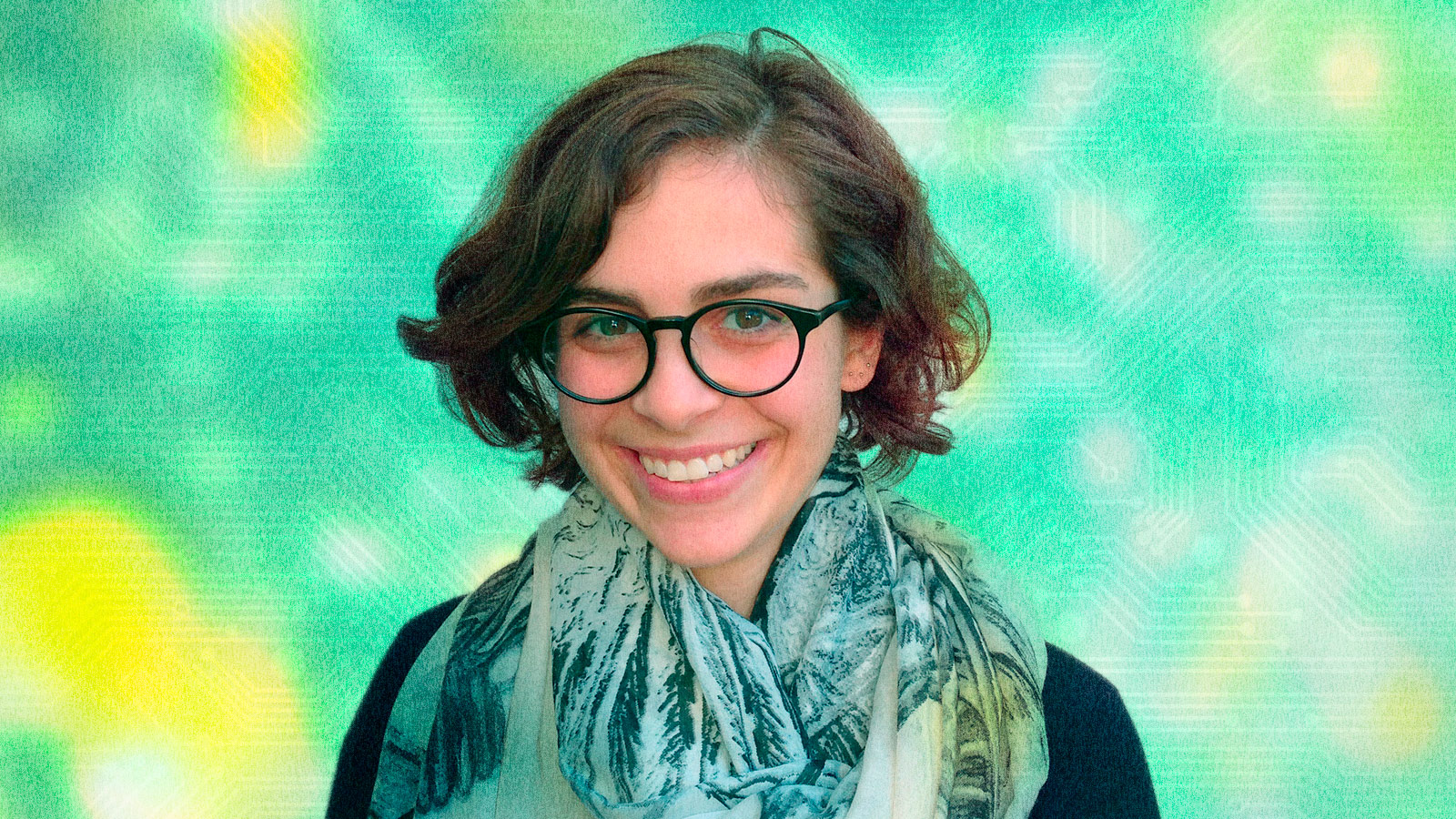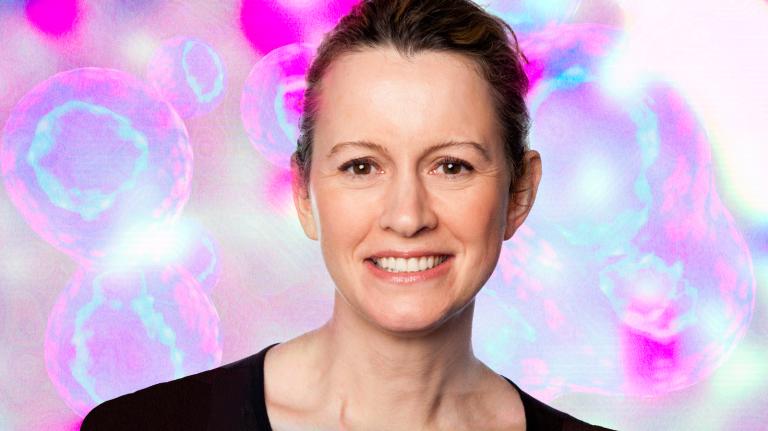Microbes are everywhere. They’re too small for the eye to see, but these bacteria, yeast, and other microscopic creatures are in the soils that grow our crops, in the air around us, all over our skin, and inside our guts. Each one of us, in fact, is host to more bacteria than actual human cells. And the more we learn about these invisible ecosystems, the clearer it becomes how much our lives and the environment depend on them.
To Cristina Agapakis this is all very exciting.
A young microbiologist, Agapakis is the new creative director at a Boston-based biotech company called Gingko Bioworks, where scientists design microbes that can churn out the complicated molecules that we use for things like perfumes or sweeteners. Agapakis is also a writer, artist, and passionate science communicator who says that, in the coming decades, advances in biotechnology could breath new life into our industrial society.
“I think a lot of companies were in the industrial revolution, moving away from biology and living things,” she says. “Now we’re going back to biology with a different kind of approach, and a different vision.”
Nature is a master engineer, after all. We may like to think humans hold that title, but the truth is: We can build cars and skyscrapers and smartphones by the millions, but a single living cell? Not a chance.
That’s all beginning to change, Agapakis says, now that the genomics revolution has set us on the fast track to understanding and manipulating the basic building blocks of life.
Agapakis was a graduate student at Harvard University when she first fell in love with what has recently become the ultimate form of genetic manipulation: synthetic biology. She was studying pharmacology when she dropped in on a lecture about the emerging field. It was all DNA editing and custom-built organisms and grand visions of using biology as a new kind of technology.
“For me, at 22, that was really really exciting,” Agapakis says. “What could we do with biology? How could we use biology to change the world?”
[grist-related-series]
Granted, there are troubling and controversial implications to that question. When does genetic tinkering cross the line from useful tool to dangerous instrument of our worst impulses? How do we weigh the benefits of a potentially life-saving new crop against the ecological risks? Should we bring extinct species back from the dead just because we can? Do we really need glow-in-the-dark plants?
But as risky as this technology is, it also holds great promise for improving human health and sustainability. Some of the earliest applications of synthetic biology, for example, involve redesigning the digestive systems of microbes to convert sugar into chemicals that we might otherwise manufacture or extract in environmentally intensive ways. And how cool would it be if we could deploy specially engineered bacteria to fight off their antibiotic-resistant brethren?
And so Agapakis dropped pharmacology and joined a group of synthetic biologists at Harvard who were trying to design photosynthetic animal cells and engineer microbes to pump out hydrogen fuel — biofuels were an especially attractive area of research, Agapakis says, because oil and gas prices were so high at the time.
By 2011, Agapakis had earned her PhD with a dissertation on “biological design principles for synthetic biology” and moved to UCLA for a postdoctoral fellowship. There, she continued her work on biofuels for about a year. But even then, the technology was still far from being a viable alternative. Meanwhile, advances in natural gas technology brought oil and gas prices down, making the engineered fuels less competitive. So Agapakis decided to refocus. She spent the rest of her postdoc studying the naturally occurring microbes that live in soils and provide nutrients to plants.
“It can almost seem disappointing, I think, when you hear about the grand scale and visions and potential of synthetic biology — whatever it is — and reality,” Agapakis says.
And the reality is that scientists are just beginning to develop their genetic engineering toolkits. So while the mind-blowing possibilities of synthetic biology — biological computers, photosynthetic humans, resurrected woolly mammoths, revolutionary new fuel sources — are all theoretically possible, they aren’t going to happen any time soon.
The holdup is partly an issue of scale, Agapakis says. For now, it’s much easier to work with simple organisms, like bacteria, than with whole animals. And it’s much easier to do lab experiments than pull off large-scale commercial operations.
Still, none of that has dampened Agapakis’ enthusiasm for the field. Because in addition to giving us the ability to manipulate nature, the genomics boom gave us the ability to see and understand the microbial world like never before. And to Agapakis, that world — and our dependence on it — is utterly fascinating.
And yet, even in a time of probiotic fervor and fecal transplants, people are still largely disconnected from — and often grossed out by — the microbial world. So in 2013, near the end of her postdoc at UCLA, Agapakis decided to challenge our contentious feelings about microbes — and her own squeamishness toward funky smells — by making cheese out of bacteria from her own feet.
She teamed up with Sissel Tolaas, a Norwegian “odor artist” who once covered the walls of an art gallery in body odor to recontextualize the smell. Together, they made cheese — not only out of Agapakis’ foot bacteria, but also out of armpit, tongue, tear, and belly button bacteria from a cast of other characters, including a California cheesemaker, a Danish-Icelandic artist, and world-famous omnivore Michael Pollan. They displayed their creations in an exhibit called “Selfmade” in the Science Gallery at Trinity College Dublin in Ireland.
“I promise that I don’t do this to turn you off of cheese forever,” Agapakis said in a talk about the project in 2013. “But rather, to really think about how cheese is sort of part of this really interesting microbial landscape, to make you think about these beautiful connections and these beautiful metabolic activities that are going on.”
Since then, art and public outreach have become central to Agapakis’ career as a scientist. She’s written about biology — synthetic or otherwise — for a variety of publications, including The Toast and Lucky Peach, and is the founding editor of an online science magazine called Method Quarterly.
Earlier this year, Agapakis joined the team at Ginkgo Bioworks. She calls Ginkgo “the organisms company,” because it designs and builds custom organisms for its clients, most of whom are in the food and cosmetics industries.
Former MIT professor Tom Knight and a crew of newly minted PhDs founded the company in 2008 and — lucky for us — made this gem of a promotional video:
Ginkgo was the first biotech company backed by Y Combinator, a prominent Silicon Valley startup accelerator known for launching successful tech companies like Reddit, Dropbox, and Airbnb. Today, Ginkgo has a snazzy new promo video, a bigger staff, and way more money — just this year, they raked in more than $50 million in funding.
Agapakis’ job as creative director is to help potential clients figure out how to (responsibly) incorporate synthetic biology into their operations, whether that means using microbes to make a new sugar substitute or the scent of a rose.
“There are a lot of different industries that are slowly approaching biology as a way to make stuff,” she says. “We have all of these ingredients, things that came from nature originally and then we looked to chemistry to recreate them.” The question Gingko is trying to answers is: “How can we re-incorporate biology in the way that we produce these ingredients?”
Eventually, the team at Ginkgo — along with the rest of the synthetic biology community — hopes to tap into some of the more aspirational applications of the field. With funding from DARPA, they’ve already begun working on microbes that could fight antibiotic-resistant bacteria, say, or capture CO2 from the air to turn it into useful chemicals or biofuels.
But Agapakis says that while the beginner-level work that Ginkgo does — using microbes to make perfumes and scents and sweeteners — might not have the same allure as the field’s grand visions, it’s these kinds of subtle applications seeping into our everyday lives that could ultimately lead us to rethink our concept of nature, and where humans and our technologies fit into it.
“One thing that always strikes me when one looks historically at what people say the future is going to be like is that we can overestimate the potential for technological change and underestimate the potential for social change,” she says.
Last year, Agapakis interviewed scientists at a company called AOBiome for a podcast about their new spray-on bacteria. The company, co-founded by a scientist who hadn’t showered in 12 years, promotes its spray as a way to nurture and protect our skin microbes, rather than wash them down the drain.
So even if photosynthetic animals aren’t on the horizon, Agapakis says, “living technologies” like these are already infiltrating our human and machine-centric world in other, more subtle ways — and perhaps that, in the end, is the more interesting story.



